
Possible sources of error
Things need to be learned, even how to use PU foam cans. But rest assured, you do not need to make all the mistakes yourself. You can simply read how to do things properly here. Or as Winston Churchill said: “A clever man does not make all the mistakes himself. He also gives others the opportunity.”
Before you get started
We have summarized the most important hacks for the correct use of PU foam for you in a presentation. It is particularly suitable for teaching. Of course, everyone else will also find a perfect summary here.
Too little or too much PU foam comes out of the PU foam can?
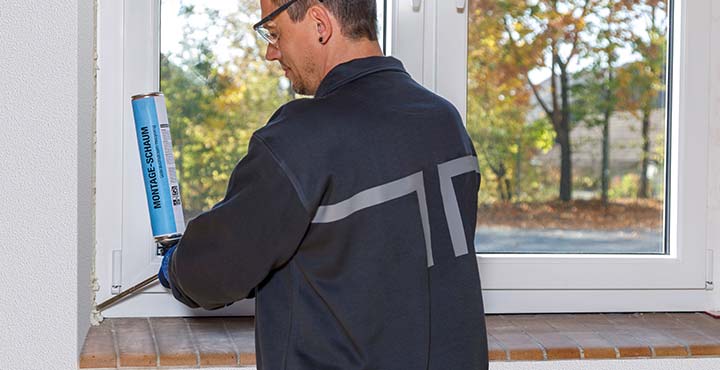
Possibility 1: If this is a 1-K PU foam, ensure that you have shaken the can sufficiently (approx. 20 – 30 times). Read the instructions on the packaging to see how well the can needs to be shaken.
Possibility 2: 2-K PU foam may not have been shaken sufficiently and / or the hardener (activation wheel on the base of the can) has not been activated correctly or at all. Typically here, the hardener was turned in the wrong direction or was not turned far enough. The hardener activation process varies from manufacturer to manufacturer. For more information, please see the packing instructions.
Possibility 3: There are even more possibilities, if you are working with gun foam:
- The PU gun foam that is used and the can do not match. The valve will not open at all or only partially. In this case, simply choose a matching gun.
- The gun that is used is soiled, which is why the foam cannot exit. In this case, you will need to clean or replace the PU foam gun.
- The opening ball in the gun has become stuck, which is why the valve cannot open. This happens when the gun was only superficially cleaned with acetone after the last time that it was used. In this case you can try to carefully release the opening ball of the PU foam gun with a toothpick. Never use tools on the can valve.
Possibility 4: The can valve itself is clogged, for instance because the PU foam can was stored incorrectly. In this case, you need to take a new can! Never try to open a construction foam can with force. This could easily damage the can and cause the contents to escape suddenly. In the most favourable case, the result is irreparable contamination, in the worst case personal injuries.
Possibility 5: It is also possible for a PU foam to be too cold! The colder it is, the tougher the PU prepolymer becomes in the can and the more difficult it becomes for it to exit. It is best, if you protect your cans against the effects of the weather. If the cans have already become too cold, you can warm them slowly in a water bath. But be careful! If a can is heated too quickly and too strongly, the gas in the can may expand too quickly, which could lead to explosions! Immersion heaters, Bunsen burners or even hot radiators are taboo when dealing with compressed gas cans!
Possibility 6: The can being used is too old. You can tell if a construction foam can has exceeded its storage date when you shake it. If the content is fluid, the foam is okay. If the foam feels too viscous during shaking, the can is too old.
Here is an important piece of advice:
Before you start your work, always test on a piece of card or newspaper to check that the foam is mixed correctly and exits the can properly.
The PU foam runs down the window joint and does not stay in place?
This happens in particular on joints that are too large, if they are filled with foam from top to bottom. It is always best, if foam is applied from bottom to top, so that the fresh foam sticks to the previously applied foam.
The construction foam exits the other side of the joint?
One possible reason for this is that the valve was opened too wide and too much foam was applied too quickly. Professionals follow the motto: slowly and surely.
The PU foam oozes excessively from the joint and soils the surrounding area?
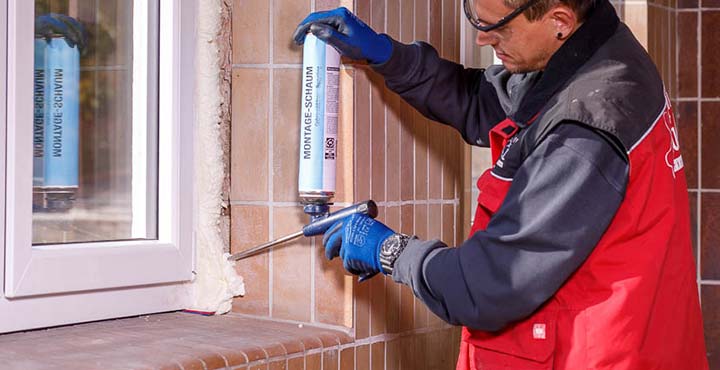
Probably, too much foam was applied. A basic rule of thumb is that the joint should only be half-filled with PU foam so that the hardening foam can expand easily. Here too, it helps to practice first on newspaper to get a feeling for how the PU foam expands. Anyone who is uncertain should mask off the surrounding area and/or protect it with film and paper.
The PU foam does not adhere to the surface and/or the edge adhesion is deficient?
This may have a number of reasons.
Possibility 1: The surface is soiled and should be cleaned.
Possibility 2: The surface is not suitable for PU foam. PU foam will not adhere to polyethylene, silicone, Teflon or similar materials – neither will it adhere to materials with oily, greasy or silconized surfaces.
Possibility 3: The surface is not load-bearing. This can be the case, for instance with gypsum. These kinds of surfaces need to be treated with a primer first.
The PU foam appears mushy and no homogeneous fine cell-like foam pattern can be formed?
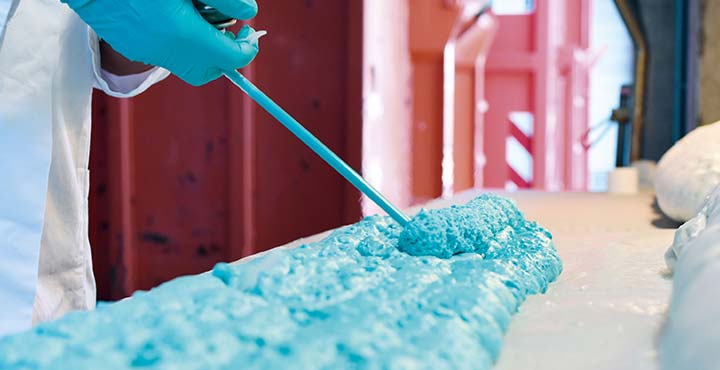
In the case of 1-K PU foam, the likely cause is that the can was not shaken sufficiently. There is more information on the packing instructions.
In the case of 2-K PU foam, the likely cause is that the hardener has not been activated correctly or at all. Typically here, the hardener was turned in the wrong direction or was not turned far enough. The hardener activation process varies from manufacturer to manufacturer. For more information, please see the packing instructions.
The PU foam is brittle and fragile, and also the curing process takes a very long time?
Is the outside temperature below 5 °Celsius? If yes, this is too cold for normal PU foam. It is advisable to use special winter foam in this case. This usually works up to -10°C.
The applied PU foam loses its stability and turns fluid?
Either the PU foam can is too warm or the outside temperature or both. PU foam usually works up to temperatures of around 35°C. There are more details about the foam used on the packaging. If only the can is too warm, it can be brought to the operating temperature in a cool water bath. If the weather is generally too hot, wait until the weather cools down.
The foam does not cure correctly, although it looked good when the foam was applied?
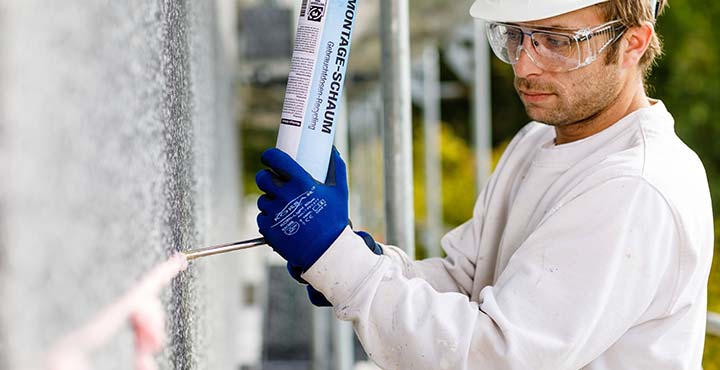
There may be several reasons for this.
Possibility 1: Was the foam cut too early? One sure sign of this is when the knife gets stuck during cutting. This leads to flaws in the hardening process and the fluid foam will collapse. If this is the case, you may need to apply foam into the joint again. The curing times of the PU foam used are stated on the packaging instructions.
Possibility 2: The 1-K PU foam had too little moisture to react. This frequently happens when filling tubes or door thresholds because there is very little humidity available in tight spaces. Either you use 2-K PU foam from the outset, because this does not need moisture for the curing process, or you can wet the individual layers with water below the foam.
The foam shrinks and does not adhere correctly?
In this case, there may be too much moisture. Too much water also damages the foam! Usually, slight wetting with an atomiser is sufficient. Here, too, there is information about the correct amount in the packaging instructions.
The PU foam still expands weeks later?
This happens when the 1-K foam did not have enough moisture for the curing process and the core was therefore not able to cure correctly. If the humidity increases at a later date, the chemical reaction starts again and the foam expands again.
After a few weeks, the foam surface becomes brittle and discolour?
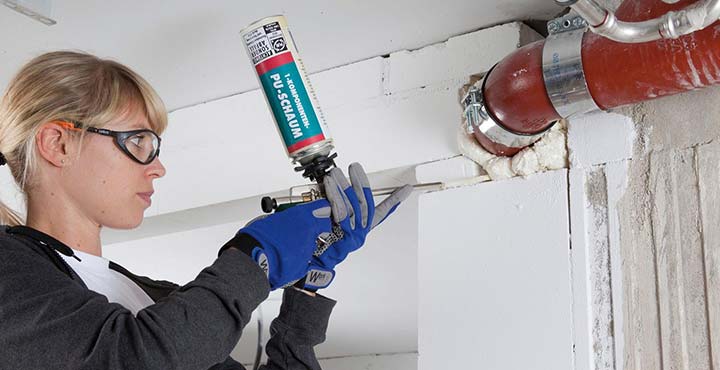
PU foams are decay and rot-proof, but not light-fast. Depending on the intensity of the radiation, the foam will discolour and becomes brittle and fragile on the surface. Therefore, it should be covered with a protective coat, plaster or other suitable materials as soon as it is completely cured to protect it from the sun.

![[Translate to Englisch:] PU-Schaumarten [Translate to Englisch:] PU-Schaumarten](/fileadmin/PU-Schaum-Center/PU-Schaumarten/img_PU-Schaumarten_bauschaum_produkt_viele_namen.png)
![[Translate to Englisch:] Bauschaum entfernen [Translate to Englisch:] Bauschaum entfernen](/fileadmin/PU-Schaum-Center/PU-Schaum_in_der_Praxis/img_Bauschaum_entfernen.jpg)
![[Translate to Englisch:] FAQ PU-Schaum [Translate to Englisch:] FAQ PU-Schaum](/fileadmin/PU-Schaum-Center/PU-Schaum_in_der_Praxis/img_Praxis_FAQ.jpg)

